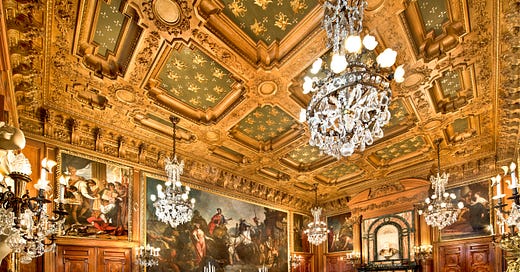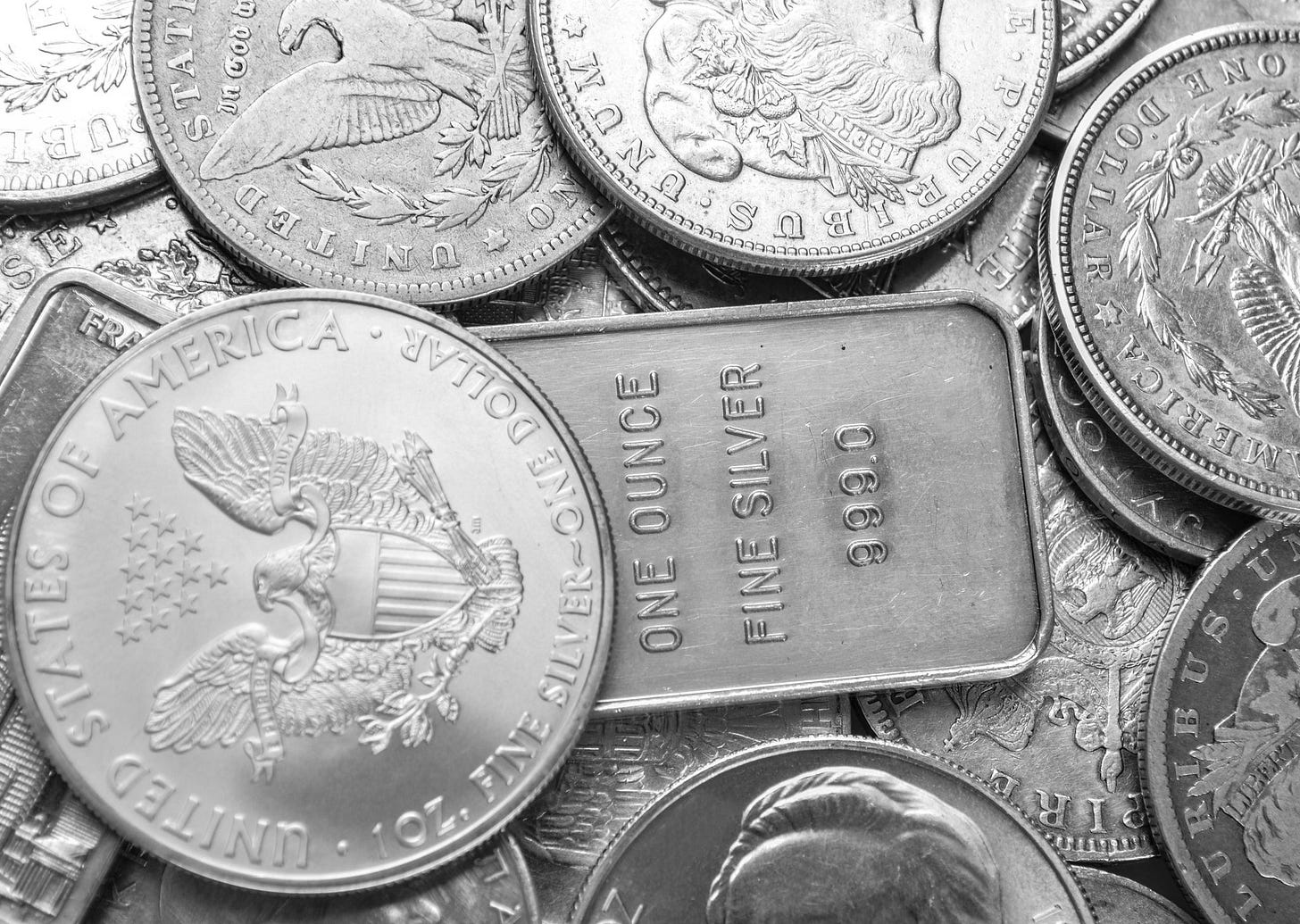The Gilded Age and the Free Silver Movement: Rejection of Fiat Currency
Harder Currency Prevailed
Gilded - Adjective - covered or tinged with gold or golden color. Having a background of wealth and luxury. (Merriam Webster).
The Gilded Age generally refers to a period in US history from around 1870 until 1900. The industrialization of the country brought tremendous economic growth. With it came a new class of uber-wealthy industrialist, financiers and businessmen. At the other end of the spectrum, millions of European immigrants came to this country for the plentiful factory and railroad jobs, which required little skills, but paid high wages.
What was this Free Silver Movement?
Gold was the official currency of the United States at the time. Gold had a long run and was one of the most successful currencies in world history. It had a fairly fixed supply, it could be minted into coins of standard denominations, and it really couldn’t be counterfeited. Any quantity of gold could be turned in to the US Mint and redeemed for gold coins. Silver, on the other hand, was not nearly as scarce and was not being used as currency.
Ordinary Americans, as you can imagine, resented the wealthy “Robber Barons” who got rich off the labor of the masses, and a populist movement arose to adopt a new monetary system. Using silver as another form of currency would allow an expansion of the money supply and of course cause inflation. Sound familiar?
Here’s the key to the plan touted by the “Silverites,” as they were called. The coinage of silver dollars would be at a ratio of 16-to-1 with gold. But silver was worth considerably less than that, and thus the concept of fiat currency was being pushed. Declaring that silver had a prescribed value. (A third form of currency was also considered at the time, “unbacked paper money.” Its proponents were known as “The Greenbacks.” That’s pretty much what we have now.)
Free Silver became a major economic policy issue in the late 1800’s.
When was the Free Silver Movement?
Silver had been demonetized in 1873, with the passage of the “Fourth Coinage Act.” Citizens could no longer turn in their silver and have it redeemed for legal tender currency. The law was described by many as the “Crime of ‘73.”
But the movement really picked up steam during the severe depression that gripped the US from 1893 until 1896. It was a period of falling prices, deflation, and a stagnant economy. Borrowers, generally the middle class, were now forced to pay back debts with dollars that were getting more expensive. The financiers and capitalists, of course, had no problem with this at all. Conversely, during periods of high inflation, like we have now, debt can be paid back with cheaper money.
Who were the teams in this battle?
The proponents of the Free Silver Movement were mainly the farmers, who generally mortgaged their properties, and the factory workers. They were mostly in the Midwest, the so-called “Wheat Belt,” and in the deep South, where cotton was grown. Further west, the silver miners were also supporters of the cause, for obvious reasons.
The pro-gold crowd, opposed to Free Silver, included the industrialists, railroad magnates, financiers, and other businessmen. Many of them were “new money” entrepreneurs and lived in the Northeast. They made loans, they rented properties, and they made lots of money. They were not interested in the United States going into a period of inflation and expanding money supply. (Think: the television series “The Gilded Age.)
Free Silver becomes a big political issue
Democrats generally supported the movement, and it was a central tenet in the candidacy of William Jennings Bryan in 1896. In support of free silver, Bryan gave a popular speech, which became known as the “Cross of Gold” speech. Free Silver became known as “The People’s Money.”
Republican William McKinley was a proponent of the gold standard, and he was the choice of the wealthy Americans. McKinley won both elections, in 1896 and 1900, and served as president until his assassination in September 1901.
The movement even spawned its own political party, The Populist Party. It was also called The People’s Party. Founded in 1892, it was merged into the Democratic party in 1909.
In support of the free silver cause, three large fraternal organizations also sprang up, in various areas of the country. The Silver Knights of America were headquartered in Washington, DC, and many reps in Congress were members. Patriots of America was founded in 1895 and based in Chicago. It lasted only through 1896. Freemen’s Protective Silver Federation began in Spokane, Washington. It boasted over half a million members and lasted until the 1920’s.
Free Silver was soundly defeated
With the Republican McKinley winning the presidency in 1896 and being re-elected in 1900, the country had rejected the concept of an expanding money supply. They had voted in favor of using the hardest currency available, gold. The US would remain on the gold standard until 1971, when President Nixon gave us the first fiat currency. (See last week’s newsletter.)
Americans of the Gilded Age had rejected fiat currency in favor of the soundest money in history, up to that point, gold. Expanding the money supply and causing runaway inflation were seen as damaging to the nation.
Fast forward to present day. We have fiat currency, the money supply has increased exponentially in the last ten years, and we have record inflation and receding GDP. We don’t have a gold standard any more.
Bitcoin is the soundest, hardest money ever created. The only currency with a hard, fixed cap. And better than gold in so many ways. It’s portable, divisible, and easily transferable.
Will the world reject fiat currency again, and adopt the hardest money available? It’s still early. Stay tuned.
Author’s note - I’ve been working as a background actor on the HBO series “The Gilded Age.” While researching the actual Gilded Age, I came across the Free Silver Movement. I just knew there had to be a hard money-versus-fiat money angle.
Recommended Bitcoin Tools, Platforms, Podcasts:
Gemini - My choice for buying and HODLing Bitcoin, rated tops for safety and security. User-friendly platform and phone app. Earn Bitcoin rewards as well with the Gemini Credit Card.
Arculus - The crypto hardware wallet from Arculus is one of the best products on the market for storing your coins. Very easy to set up and to use, and very affordable.
Lolli - The Lolli shopping app lets you earn great Bitcoin rewards on practically everything you buy, whether you’re shopping on your phone, computer, or in-person.
Twitter - Follow The Bitcoin Files on Twitter at @BitcoinNewslet1 for all of my articles, commentary and links to my contributions to Bitcoin Magazine.
Medium - Check out my writings on Medium, including articles not featured in the newsletter. Join my 550 other followers who read and write about crypto. medium.com/@rickmulvey
Podcasts - To hear the top names in Bitcoin, and learn more than you could imagine, check out The Pomp Podcast with Anthony Pompliano, What Bitcoin Did with Peter McCormack, and The Wolf of All Streets Podcast with Scott Melker.
Issue No. 72, September 2, 2022
Rick Mulvey is a CPA, crypto consultant, and frequent contributor to Bitcoin Magazine. He writes about all things Bitcoin, and yells at the Yankees and Giants. He also runs marathons and makes wine, neither professionally.






